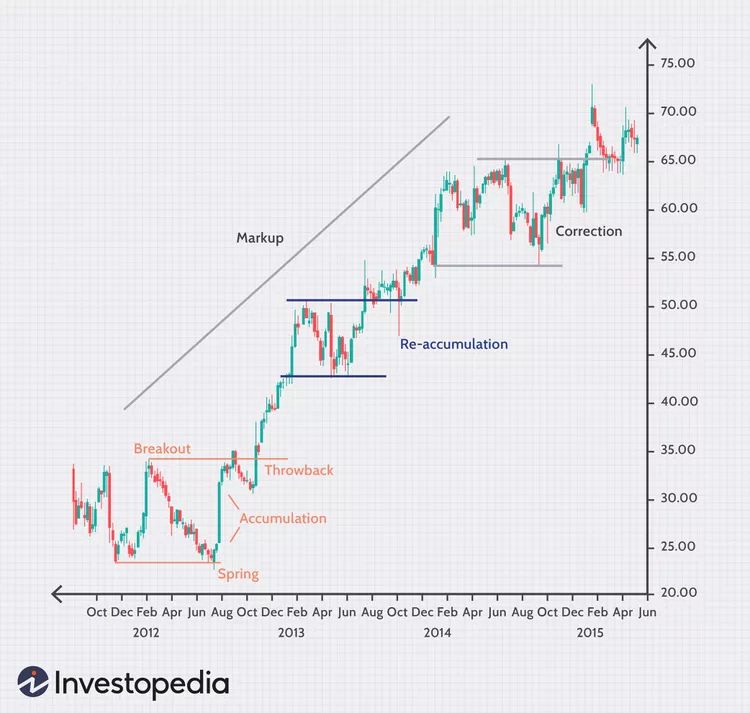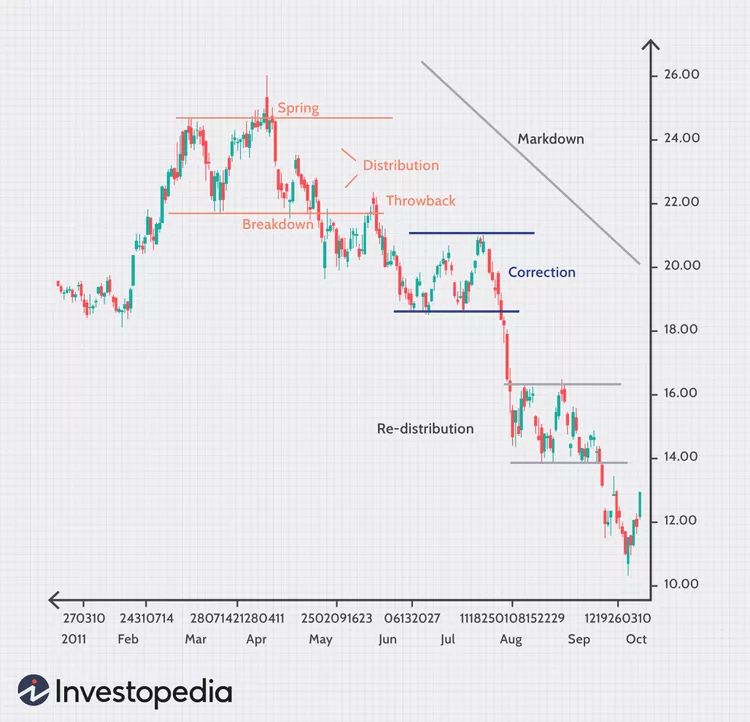One of the most respected and time-tested strategies in technical analysis is the Wyckoff Method—a trading approach developed by legendary stock market technician Richard D. Wyckoff in the 1930s. This methodology is based on understanding market cycles through the relationship between price action and trading volume, helping traders anticipate potential market moves with greater confidence.

But how does the Wyckoff Method work in today’s volatile crypto market? Can a tool built nearly a century ago still guide modern crypto investors? Let’s dive into the essentials of the Wyckoff Pattern and how you can use it to refine your trading strategy.
What is the Wyckoff Pattern?
A tried-and-true method for predicting market movements, the Wyckoff Method analyzes price and volume patterns to provide traders with this ability. Developed in the 1930s by Richard Wyckoff, this method provides an in-depth analysis of price movement mechanics and market psychology.
Wyckoff’s fundamental belief is that strong players control supply and demand in marketplaces to their benefit. Traders can recognize these patterns and predict market turning points by examining price charts, volume variations, and market activity.
Three basic principles form the basis of the method:
Market Manipulation
Wyckoff suggested that large institutions often manipulate the market to accumulate or offload their positions without drawing attention. These manipulations create recognizable patterns that traders can learn to identify.
Supply and Demand
The exchange between sellers and buyers keeps the market alive. Wyckoff underlines that mismatches between supply and demand create the potential for significant price swings.
Institutional investors
These ideas, commonly known as “smart money,” have a huge impact on market trends. Recognizing what they do can provide valuable insights into future market behaviors and movements.
Wyckoff Method Phase
There are four main stages to the Wyckoff Pattern: accumulation, uptrend, distribution, and decline. Below is a summary of every stage:
Accumulation and Markup Phase
Accumulation using the Wyckoff method is the initial phase, characterized by sideways price movement within a specific timeframe. While appearing stagnant, some large investors are quietly accumulating assets.
Once buying pressure surpasses selling pressure, a Markup Phase begins, marked by a decisive breakout above the accumulation range. Subsequent pullbacks, or “throwbacks,” offer potential entry points for traders.
The Markup Phase may include brief consolidation periods known as “reaccumulation zones,” allowing the market to recharge.
However, a consistent failure to create new highs after pullbacks signals potential uptrend weakness and a possible transition to the distribution phase.

Distribution and Markdown Phase
After the market’s climb, a subtle change happens as experienced investors quietly unwind their positions. A narrow trading range emerges, concealing the fundamental distribution process.
Prices fluctuate within a narrow range, attracting new, generally less sophisticated investors. However, as selling pressure increases, this façade of steadiness begins to shatter.
Prices begin to fall, interrupted by brief rallies that can be deceiving. Astute traders see these as opportunities to quit or short the market.
Finally, a redistribution phase occurs, characterized by significant selling and price reductions, culminating in a market bottom. This period is distinguished by heightened volatility as panic selling grips the market and investor sentiment changes rapidly.

How To Identify and Read Wyckoff Pattern?
To effectively interpret the Wyckoff Pattern, it’s crucial to identify when a breakout occurs during the accumulation phase.
As previously explained earlier, this breakthrough signals the conclusion of the accumulation phase and the start of a substantial price increase.
Here are some key indicators that can help to identify and confirm the breakout:
- Spring or Shakeout: A rapid price decrease before the breakout, known as a spring or shakeout, might help to eliminate weaker market participants, laying the groundwork for an upward surge.
- Volume Confirmation: The breakout’s significance is reinforced by the increased trade volume that accompanies it. This rise implies increased buying demand, which increases the chance of a long-term rise. However, reduced volume during future pullbacks can be bullish.
- Price Action: A significant move over the previous resistance level is required for a confirmed breakout. Technical indicators like trendlines and moving averages might provide extra proof.
- Backing-Up Action: A transient market pullback to the newly created support level (former resistance) following a breakout, known as backing-up action, might strengthen the breakout’s legitimacy. A successful retest of this level would support the bullish picture.
Can the Wyckoff Method Used In Crypto Trading?
Absolutely. In fact, the Wyckoff Method aligns perfectly with the behavior of the crypto markets, which are often driven by emotion, speculation, and sudden shifts in sentiment.
The method’s focus on market psychology, volume dynamics, and institutional behavior makes it a powerful tool for navigating Bitcoin, Ethereum, and altcoin charts.
Many large crypto price moves—including Bitcoin’s major bull runs—exhibit clear Wyckoff patterns in hindsight. With training and discipline, you can start spotting them in real time.
How To Use Wyckoff Pattern On Crypto Trading?
To implement the Wyckoff Method effectively in crypto:
- Practice Patience: The Wyckoff Method works best over time. Avoid FOMO and wait for confirmation of each phase.
- Study the Market Structure: Learn to identify accumulation and distribution zones on major timeframes (4H, daily, weekly).
- Use Volume Analysis: Crypto exchanges offer detailed volume data. Watch how it behaves around support and resistance.
- Combine with Technical Indicators: Use trendlines, moving averages (e.g., 50MA/200MA), and RSI to confirm setups.
- Track Smart Money Activity: Look for large volume spikes, sudden reversals, and fakeouts around key levels.
Personal Note From MEXC Team
Check out our MEXC trading page and find out what we have to offer! There are also a ton of interesting articles to get you up to speed with the crypto world. Lastly, join our MEXC Creators project and share your opinion about everything crypto! Happy trading! Learn about interoperability now!
Join MEXC and Get up to $10,000 Bonus!
Sign Up


